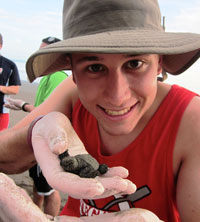
Name: Kent Schnacke
Education: B.S. in Biology at Colorado State University
Hometown: Centennial, Colorado
Career goal: Obtain a Professional Masters of Science at CSU in aquarium, zoo and shelter management.
Favorite Memory: Celebrating Christmas and the end of the year with parties. “It’s not so much a work environment, obviously it is in the lab, but outside of it there’s kind of a little community,” Kent reveals. “So it’s kind of nice to have people that care and people that are interested in other aspects of your life, too, besides just the lab.”
Project: Effects of hypoxia on AMP Kinase mRNA expression in the European green crab, Carcinus maenas
Kent hypothesizes that as crabs become stressed, their AMP-kinase levels increase, which stops them from molting. The enzyme AMP-kinase helps regulate the molt cycle by catalyzing DNA reactions. However, Kent discovers that once a crab’s stress level reaches a certain point, the levels of AMP-kinase decrease, along with the levels of a housekeeping gene called EF2 that regulates normal cell function. EF2 levels should remain constant no matter what the treatment. “That could mean the animals are getting to a point where they’re too stressed even to do normal bodily functions,” Kent said. “Decreased levels of AMP-kinase and EF2 could mean the animals are stressed to a point where they’re not going to recover.” These observations lead Kent to believe crabs may deal with hypoxia, or oxygen deprivation, using something other than AMP-kinase. To find the levels of AMP-kinase, Kent isolates the tissue samples’ mRNA. He then puts the mRNA sample into a Polymerase Chain Reaction (PCR) machine to copy it into complementary DNA (cDNA) and transfers the cDNA into a Quantitative PCR machine to measure the amount of cDNA and find the levels of AMP-kinase in stressed crabs.
Primary Investigator
Undergraduate
- Matt Donovan
- Talia Head
- Hannah Jesberger
- Hanna Schulz
- Kent Schnacke
